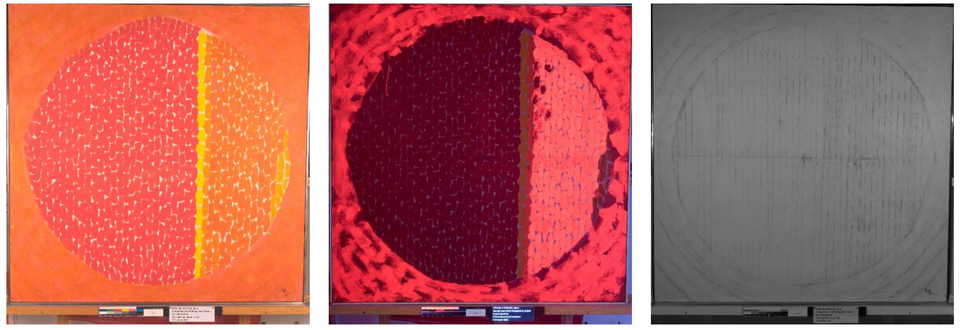
Getting Started
Regardless of the monetary value of your artwork, if it is personally meaningful, you should consider having the object conserved. It is very important to have trained professionals do the job. Your local art museum, gallery, or historical society can recommend reputable conservators in your area.
For guidelines on selecting a conservator and a list of professional conservators in your area, contact the following organizations:
American Institute for Conservation of Historic & Artistic Works (AIC)
1156 15th Street, NW, Suite 320
Washington, DC 20005-1714
Phone: (202) 452-9545
www.culturalheritage.org
Staff at the Smithsonian's Museum Conservation Institute are often asked questions about caring for and preserving artifacts and heirlooms. While they cannot give advice on specific items, they have broad guidelines and strategies for artifact and collection care. For access to these resources, many of which are online, go to the Smithsonian Museum Conservation Institute's website.
Library of Congress
Preservation Directorate
101 Independence Avenue, SE
Washington DC 20540-4500
The Library of Congress also provides useful advice on preserving works on paper (drawings, prints, posters) and on caring for books, photographs, videos, and so forth. The Library of Congress has online publications that answer questions related to the care, handling, and storage of valuable collections, which can be found at www.lcweb.loc.gov/preservation/.
Conservation Organizations
The following organizations are primarily geared toward professionals, but they do serve the general public, often providing lectures and workshops in collections care.
The Conservation Center for Art & Historic Artifacts (CCAHA)
264 South 23rd Street
Philadelphia PA 19103
(215) 545-0613
www.ccaha.org
Northeast Documentation Center (NEDCC)
100 Brickstone Square
Andover MA 01810-1494
(978) 470-1010
www.nedcc.org
Regional Alliance for Preservation (RAP)
A consortium of regional conservation centers.
http://rap-arcc.org/
Additional Conservation Reading
Here are some recommended resources for additional conservation reading.
- Bachmann, Konstanze, ed. Conservation Concerns: A Guide for Collectors and Curators.Washington, D.C.: Smithsonian Institution Press, 1992.
- Clapp, Anne F. Curatorial Care of Works on Paper. Oberlin, Ohio: Intermuseum Conservation Association, 1978.
- Dollof, Francis W., and Roy L. Perkinson. How to Care for Works of Art on Paper. Boston: Museum of Fine Arts, 1979.
- Ellis, Margaret Holben. The Care of Prints and Drawings. Nashville: American Association for State and Local History, 1987.
- Keck, Caroline. A handbook on the care of paintings. Nashville: The American Association for State and Local Histories, 1965.
- Long, James S. Caring for Your Family Treasures. New York: Heritage Preservation and H.N. Abrams, 2000.
- National Committee to Save America's Cultural Collections. Caring for Your Collections.New York: H.N. Abrams, 1992.
- Simpson, Mette Tang, and Michael Huntley, eds. Sotheby’s Caring for Antiques: a guide to handling, cleaning, display and restoration. London: Conran Octopus, 1992.
- Zigrosser, Carl, and Christa M. Gaehde. A Guide to the Collecting and Care of Original Prints. New York: Crown Publishers, 1969.
Collection Documentation
Caring for your collection extends beyond maintaining the physical condition of the objects. It is important to keep good object records and a collection history. This data will be invaluable for insurance purposes in case of theft or disaster. Be sure to create a folder for each object in your collection.
In your file, include the following items:
- color photographs of the object, including full-view and details—front, back, framed, unframed. Document multiple views of three-dimensional works.
- purchase date and price
- vendor data
- artist/maker information including life dates
- title of work
- detailed description of object’s subject matter or type of work
- date of work
- dimensions—framed and unframed for two-dimensional works. Overall, object, and base measurements for three-dimensional works.
- media and support data
- detailed description of object—include location of scratches, losses, dents, abrasions, and so on
- copies of all conservation and appraisal reports
- text of inscriptions, markings, and labels
- ownership history (“provenance”)
- bibliographic information if your work is cited in any exhibition catalogues, auction catalogues, or catalogues raisonné
- exhibition and loan history
See the Getty website for information on protecting cultural objects through international documentation standards at www.getty.edu/conservation/
Resources for Stolen Art
In the unfortunate event your artwork gets stolen, here are important resources:
International Foundation for Art Research (IFAR)
500 Fifth Avenue, Suite 935
New York NY 10110
(212) 391-6234
www.ifar.org
Select the Collector's Corner link. National Stolen Art File
https://www.fbi.gov/investigate/violent-crime/art-theft













